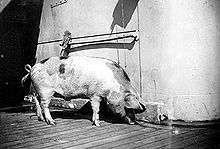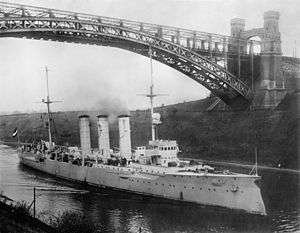Tirpitz (pig)

Tirpitz was a pig captured from the Imperial German Navy after a naval skirmish following the Battle of the Falkland Islands in 1914. He subsequently became the mascot of the cruiser HMS Glasgow.
Early life

Pigs were often kept on board warships to supply fresh meat. Tirpitz was aboard SMS Dresden when she was ordered into the South Atlantic to join with the forces of Vice Admiral Maximilian von Spee to begin raiding allied merchants. The ship's first encounter with the HMS Glasgow was at the Battle of Coronel, where the German fleet was victorious. They were subsequently defeated at the Battle of the Falkland Islands, though the faster Dresden managed to escape. She was located in Cumberland Bay on the Chilean island of Más a Tierra (today known as Robinson Crusoe Island), by HMS Glasgow and HMS Kent off the coast of South America on 15 March 1915. The Germans scuttled the ship, but Tirpitz was left on board as she sank.
Capture and Royal Navy service
.jpg)
Tirpitz was able to make his way above deck and swim clear of the sinking Dresden. He struck out for the nearby Royal Navy ships and was spotted an hour later by a petty officer aboard HMS Glasgow. The officer entered the water, but the frightened Tirpitz nearly drowned him. He was however eventually able to rescue the pig and bring him aboard. 'Tirpitz' was subsequently adopted by the crew of HMS Glasgow, who made him their mascot, and named him 'Tirpitz', after Alfred von Tirpitz, the German Admiral, and Secretary of State of the Imperial Naval Office. Tirpitz remained with the Glasgow for a year and was then placed in quarantine until he was allowed to be adopted by the Petty Officer who had first seen him, who transferred him to Whale Island Gunnery School, Portsmouth for the rest of his career.[1] The Times newspaper reported:
'The animal, which is known as 'Tirpitz', was once owned by the German light cruiser Dresden, and when, during the action with Glasgow, Kent, and Orama, the Germans escaped to the shore after causing an explosion which sank the Dresden, and 'Tirpitz' was left to its fate, the pig struck out boldly, and was seen swimming near the Glasgow. Two sailors dived into the sea, and the animal was brought safely aboard. The ship's company of the Glasgow awarded 'Tirpitz' an 'Iron Cross' for having remained in the ship after its shipmates had left, and it became a great pet.'[2]
As a fundraiser
Tirpitz was eventually auctioned off for charity as pork in 1919. He ultimately raised £1,785 for the British Red Cross.[3] Tirpitz was latterly bought by William Cavendish-Bentinck, 6th Duke of Portland, who donated Tirpitz's stuffed head to the Imperial War Museum.[4][5] Tirpitz's head was put on display as part of the museum's original exhibition at The Crystal Palace in 1920,[4] and also featured in the museum's 2006 temporary exhibition 'The Animals' War'.[6]
Another of Tirpitz's legacies was bequeathed to the next HMS Glasgow, which retained a pair of silver mounted carvers made from Tirpitz's trotters.[7] These carvers were later also acquired by the Imperial War Museum.[8]
Notes
- ↑ Imperial War Museum (3 August 2006). "Animals at War exhibition captions" (PDF). archive.iwm.org.uk. Retrieved 8 December 2011.
- ↑ "A Dresden survivor". The Times. 5 December 1917. p. 8.
- ↑ Kennedy, Maev (13 July 2006). "Museum honours dogs - and ferrets - of war". The Guardian. Retrieved 11 December 2011.
- 1 2 "Imperial War Museum: Opening by the King next month". The Times. 8 May 1920. p. 19.
- ↑ Imperial War Museum. "mounted stuffed pig's head, Tirpitz the Pig". IWM Collection Search. Retrieved 15 December 2011.
- ↑ The Independent newspaper's review of the Imperial War Museum's exhibition
- ↑ Report on trophies of later HMS Glasgow
- ↑ Imperial War Museum. "carvers, fork and knife, made from the trotters of "Dennis" (Tirpitz) Dresden's Pig". IWM Collection Search. Retrieved 12 November 2012.